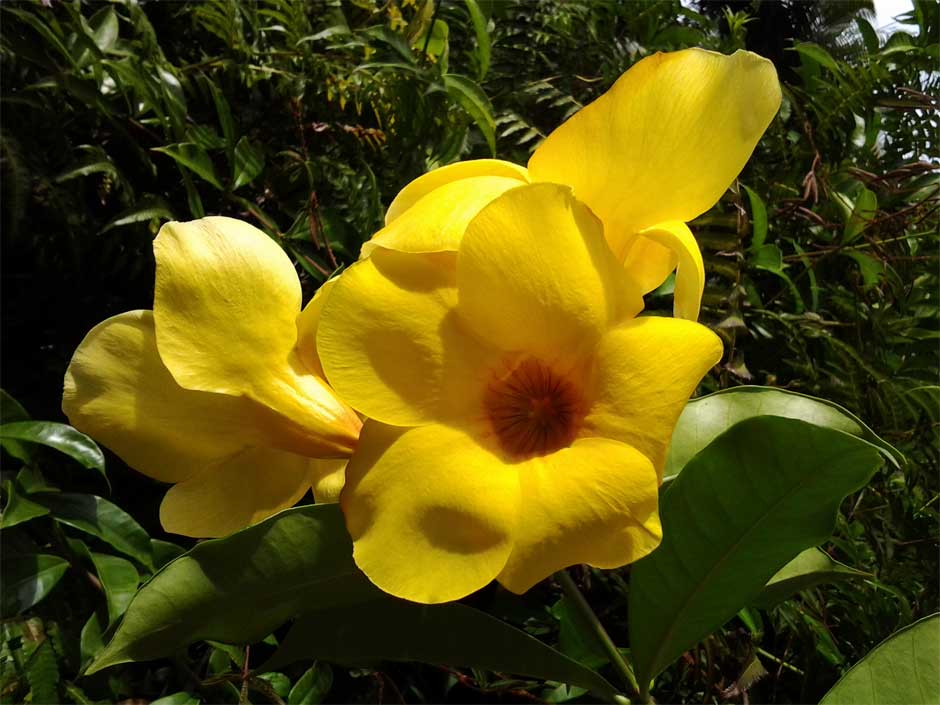NAME: Allamanda cathartica
FAMILY: Apocynaceae
COMMON NAMES: Yellow allamanda, Angel's trumpet, Butter-cup, Golden trumpet, Guinea herb
LOCAL NAMES: Ododo-alamanda, canario, ruan huang chan
USEFUL PART(s): Roots
GENERAL USES:
The shrub serves as wind-breaker
It can also be use for demarcation and support
GEOGRAPHIC DISTRIBUTION
Brazil
Sri Lanka
Australia
China
USA
Fiji
Honduras
Costa Rica
Nicaragua
Puerto Rico
WHY IS IT GREEN?
Allamanda cathartica medicinal values include:
Antimicrobials
Malaria
Dysentery
Cathartic.
ENVIRONMENTAL IMPACT
Ornamental plant
Environmental weed in some areas
FACT
The parts of the plant are toxic to both farm animal and man and contains milky latex
It is a woody vine whose flower is yellow and has a trumpet shape
It is propagated by seed and stem cutting
FURTHER READINGS
Bonomini, T. J., Holzmann, I., Thiesen, L. C., Fratoni, E., Muller, A. F. F., Lucinda-Silva, R. M., … Santin, J. R. (2017). Neuropharmacological and acute toxicological evaluation of ethanolic extract of Allamanda cathartica L. flowers and plumieride. Regulatory Toxicology and Pharmacology, 91, 9–19. https://doi.org/10.1016/j.yrtph.2017.10.005
Chaveerach, A., Tanee, T., Patarapadungkit, N., Khamwachirapithak, P., & Sudmoon, R. (2016). Cytotoxicity and genotoxicity of Allamanda and Plumeria species. ScienceAsia, 42(6), 375–381. https://doi.org/10.2306/scienceasia1513-1874.2016.42.375
Conrad, O. A., Dike, I. P., & Agbara, U. (2013). In vivo antioxidant assessment of two antimalarial plants-Allamamda cathartica and Bixa orellana. Asian Pacific Journal of Tropical Biomedicine, 3(5), 388–394. https://doi.org/10.1016/S2221-1691(13)60082-9
Karunakaran, G., Jagathambal, M., Gusev, A., Kolesnikov, E., Mandal, A. R., & Kuznetsov, D. (2016). Allamanda cathartica flower’s aqueous extract-mediated green synthesis of silver nanoparticles with excellent antioxidant and antibacterial potential for biomedical application. MRS Communications, 6(1), 41–46. https://doi.org/10.1557/mrc.2016.2
Okoduwa, S. I. R., Mbora, L. O., Adu, M. E., & Adeyi, A. A. (2015a). Comparative Analysis of the Properties of Acid-Base Indicator of Rose ( Rosa setigera ), Allamanda ( Allamanda cathartica ), and Hibiscus ( Hibiscus rosa-sinensis ) Flowers. Biochemistry Research International, 2015, 1–6. https://doi.org/10.1155/2015/381721
Okoduwa, S. I. R., Mbora, L. O., Adu, M. E., & Adeyi, A. A. (2015b). Comparative analysis of the properties of acid-base indicator of rose (Rosa setigera), Allamanda (Allamanda cathartica), and hibiscus (Hibiscus rosa-sinensis) flowers. Biochemistry Research International, 2015. https://doi.org/10.1155/2015/381721
Rajamanickam, K., & Sudha, S. S. (2013). In-vitro antimicrobial activity and in-vivo toxicity of Moringa oleifera and Allamanda cathartica against multiple drug resistant clinical pathogens. International Journal of Pharma and Bio Sciences, 4(1).

